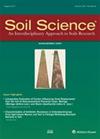受土地利用影响的热带土壤有机碳质量和可降解性与土壤地球化学的关系
4区 农林科学
Q2 Agricultural and Biological Sciences
引用次数: 0
摘要
摘要土地利用在百年至千年时间尺度上影响土壤地球化学,影响土壤有机碳(SOC)的分布和稳定性。热带地区年轻的火山土壤的成土作用要快得多,这在百年甚至十年的时间尺度上已经很明显了。由于土地利用是土壤形成的一个公认因素,因此可以想象,即使在这些地区最近的土地利用转换也会对由此形成的土壤产生重大影响。,例如,就成土氧化物的含量而言。很少有观测证据存在,因此土地利用对有机碳循环的间接影响在很大程度上是未知的。本文研究了印尼火山土壤中有机碳组分、基质特定矿化(有机碳或添加的植物残渣)和有机碳净底质对森林或农业用地的影响。草酸盐提取的Al (Alo)含量与砂级团聚体的有机碳(OC)具有良好的相关性,特别是在底土中。土壤有机碳在沙粒级抗超声(400 J mL−1)团聚体中的比例在农业用地中也高于松林用地,在Alo中也存在类似的对比。这些综合观察表明,铝(氢氧)氧化物的形成增强促进了OC的聚集和物理闭塞。重要的是,这也与农业用地中相对较低的有机碳可降解性相一致,尽管我们发现添加13c标记的黑麦草或天然有机碳在松林和农业用地之间的可降解性没有类似的差异。我们预计,与松林用地相比,农业用地下无定形铝含量主要促进有机碳的矿物关联,但没有发现这方面的迹象。由农业转化和通过有机肥的高碳输入引起的热带土壤小规模聚集的改善可能部分抵消耕作后SOC储量的预期下降。这种土地利用对有机碳平衡的间接影响似乎与正确解释和预测具有强烈发展的土壤的(农业)生态系统的长期碳平衡有关,如本文研究的热带安土。本文章由计算机程序翻译,如有差异,请以英文原文为准。
Tropical Andosol organic carbon quality and degradability in relation to soil geochemistry as affected by land use
Abstract. Land use is recognized to impact soil geochemistry on the centennial to millennial timescale, with implications for the distribution and stability
of soil organic carbon (SOC). Young volcanic soils in tropical areas are subject to much faster pedogenesis, noticeable already on the centennial or
even decadal timescale. As land use is a recognized factor for soil formation, it is thus conceivable that even relatively recent land use conversion in
such areas would already bear a significant impact on the resulting formed soils., e.g., in terms of content of pedogenic oxides. Very scarce
observational evidence exists, so such indirect implications of land use on SOC cycling are largely unknown. We here investigated SOC fractions,
substrate-specific mineralization (SOC or added plant residue), and net priming of SOC as a function of forest or agricultural land use on Indonesian
volcanic soils. The content of oxalate-extracted Al (Alo) correlated well with organic carbon (OC) associated with sand-sized aggregates,
particularly in the subsoil. The proportion of SOC in sand-sized ultrasonication-resistant (400 J mL−1) aggregates was also higher in
agricultural land use compared to pine forest land use, and a likewise contrast existed for Alo. These combined observations suggest that enhanced
formation of Al (hydr)oxides promoted aggregation and physical occlusion of OC. This was, importantly, also consistent with a relatively lesser
degradability of SOC in the agricultural sites, though we found no likewise difference in degradability of added 13C-labeled ryegrass or
in native SOC priming between the pine forest and agricultural land uses. We expected that amorphous Al content under agricultural land use
would mainly have promoted mineral association of SOC compared to under pine forest land use but found no indications for this. Improved small-scale
aggregation of tropical Andosols caused by conversion to agriculture and high carbon input via organic fertilizer may thus partially counter the
otherwise expectable decline of SOC stocks following cultivation. Such indirect land use effects on the SOC balance appeared relevant for correct
interpretation and prediction of the long-term C balance of (agro)ecosystems with soil subject to intense development, like the here-studied tropical Andosols.
求助全文
通过发布文献求助,成功后即可免费获取论文全文。
去求助
来源期刊

Soil Science
农林科学-土壤科学
CiteScore
2.70
自引率
0.00%
发文量
0
审稿时长
4.4 months
期刊介绍:
Cessation.Soil Science satisfies the professional needs of all scientists and laboratory personnel involved in soil and plant research by publishing primary research reports and critical reviews of basic and applied soil science, especially as it relates to soil and plant studies and general environmental soil science.
Each month, Soil Science presents authoritative research articles from an impressive array of discipline: soil chemistry and biochemistry, physics, fertility and nutrition, soil genesis and morphology, soil microbiology and mineralogy. Of immediate relevance to soil scientists-both industrial and academic-this unique publication also has long-range value for agronomists and environmental scientists.
 求助内容:
求助内容: 应助结果提醒方式:
应助结果提醒方式:


